You can move to the next element in the list of results using the tab key.
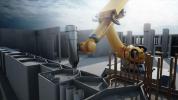
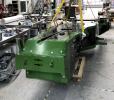
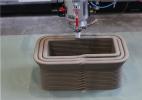
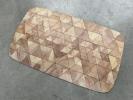
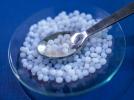
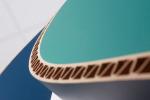
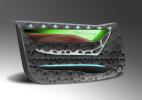
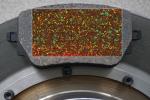
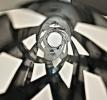
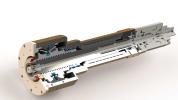
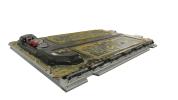
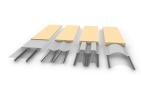

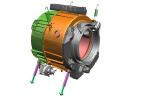
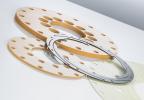

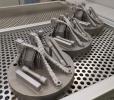

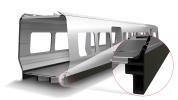
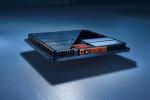
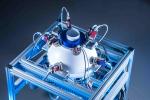

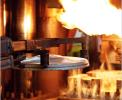

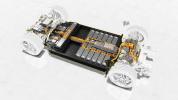
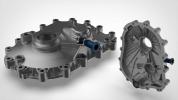
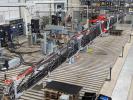
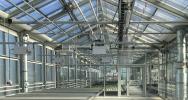
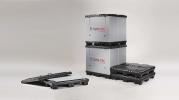


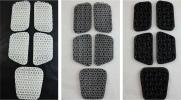
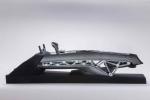
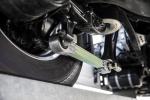
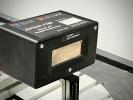
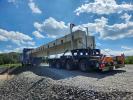

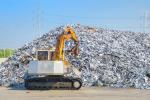
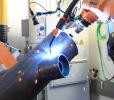
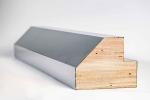



Producing concrete walls in CO2-reduced lightweight construction: mobile 3D concrete printing robots
Funding duration:
Start
01.02.22
Today
10.01.25
End
31.01.25
Processes in the construction industry have been little digitalised and automated to date. Standardised and inflexible processes often lead to inefficient use of materials, energy, time and labour. Resource-intensive concrete construction in particular causes considerable CO2 emissions. Additive manufacturing of concrete offers a solution that allows for specifically dimensioned cross-sections and significantly simplifies logistics on construction sites. Automation, digitalisation and new material approaches are considered together.
In the 3DLight_OnSite project, researchers are developing an innovative concept for 3D concrete printing. The aim of the project partners is to use individually movable printing robots to produce structural-optimised concrete walls in CO2-reduced lightweight construction, thus combining sustainability, construction robotics and efficient production. In order to make optimum use of the economic and ecological potential of concrete printing, they are relying on end-to-end digitalised and highly automated production.
The results of the research project should make it possible for mobile robot fleets to move flexibly around the construction site in future and print the concrete elements directly on site. In contrast to stationary printing systems, which are less flexible and less scalable, this will enable faster, more cost-effective and more environmentally friendly additive manufacturing.
The prototype developed by the project participants includes a crawler chassis and an industrial robot with a special nozzle head for the 3D printing process. The researchers are digitising the entire planning and production process in order to optimise the use of the robots. All relevant construction data is modelled digitally and transferred directly to the robots. Digitalised production methods also offer advantages beyond the construction process. For example, building materials can be tracked and components can be sustainably dismantled and reused in the sense of "urban mining".
The researchers are also focussing on material savings through a lightweight construction method inspired by nature. For example, CO2-intensive, high-strength concretes are only to be used where they are structurally necessary. To this end, the project participants are using structures similar to honeycombs, which offer maximum stability with minimum material consumption. For example, the wall shell of a building is constructed from pressurised mortar and then filled with foam concrete, which serves as insulation and soundproofing. This construction method significantly reduces material consumption and CO2 emissions. The project partners are also endeavouring to develop more environmentally friendly concrete mixtures.

Reducing the weight of agricultural machinery: lightweight, functionally integrated carbon chassis
Funding duration:
Start
01.06.21
Today
10.01.25
End
31.05.25
The performance of agricultural harvesters has risen sharply in recent decades. At the same time, machines are getting bigger and heavier, which presents manufacturers with various challenges. On the one hand, the high weight leads to increased soil compaction, which worsens the living conditions for soil organisms and restricts root growth and water absorption. As a result, the fertility and yield of agricultural land decreases. On the other hand, the heavier and larger machines lead to problems in complying with road traffic regulations.
The AGRILIGHT team aims to significantly reduce the weight of the harvesters through the use of innovative lightweight construction concepts. They are developing a functionally integrated lightweight structure made of glass fibre and carbon fibre composites to replace the central steel frame of the machines and integrate adjacent components - such as tanks - into the component. This change is intended to reduce fuel consumption and CO2 emissions while minimising soil compaction. In addition to the ecological improvement, the researchers would also like to simplify the road traffic authorisation of the machines thanks to the reduced weight.
To further reduce assembly times and costs, the team is developing new approaches to structural hybridisation for the particularly stressed interfaces of the machines. The aim is to be able to retain existing joining methods from metal processing for lightweight, fibre-reinforced materials.
At the start of the project, the team analysed the previous steel structure and the adjacent functional units of the harvester. They then developed the new function-integrated frame structure made of fibre-reinforced plastics (GRP/CFRP), taking into account the specific mechanical, electrical and chemical properties of these materials.
For structural hybridisation, the team used multi-layer insert technology, in which metallic inserts are integrated into the fibre composite during production. This meant that existing joining methods from metal processing could be retained and downstream work steps such as drilling and gluing could be omitted, which significantly simplified assembly.
At the end of the project, the new frame structure will undergo extensive mechanical testing to assess its suitability for series production. To do this, the researchers integrate the prototype into a realistic test setup and test the frame on a special test bench to simulate real-life operating conditions. In this way, the team ensures that the new structure remains intact over the entire service life of the machine.
The developed prototype was presented for the first time at the Hannover Messe 2024 and shows a weight reduction of over 430 kg compared to the conventional steel frame construction. The project was recognised as a finalist for the prestigious JEC Innovation Award in the Equipment Machinery & Heavy Industries category.

Finding optimal building materials: concrete construction with AI and 3D printing
Funding duration:
Start
01.06.22
Today
10.01.25
End
31.05.25
The construction industry is one of the world's largest consumers of raw materials and energy and generates large amounts of waste. A large proportion of global greenhouse gas emissions are also generated during the construction, demolition and disposal of buildings. In particular, the production of concrete - one of the most frequently used building materials - with its main component cement causes considerable CO2 emissions.
The aim of the scientists in the AIBetOn3D project is to reduce the environmental impact of the construction sector. To this end, they are asking themselves the overarching question of how 3D printing can be used in concrete construction to minimise CO2 emissions without compromising the quality of the construction products.
On the one hand, the researchers are developing simulation models for 3D printers with the support of artificial intelligence (AI), which should help to identify optimal building materials and combinations of building materials by enabling reliable predictions of material behaviour and potential CO2 savings. The researchers are also working on an innovative 3D printer for building materials and the associated software.
As a concrete application, the researchers are looking at drainage channels and inlet boxes, which are to be implemented in different variants - in 3D concrete printing, combined 3D printing with concrete and plastic moulds and clay-based 3D printing. In addition to geometric parameters, material modifications are also being investigated.
They are developing a concept for a semantically causally correlated material production library. The AI-based algorithms and models developed are thus designed to understand the meaning of the data, analyse their relationships and recognise and use the causal relationships to enable precise predictions and optimisations. The library will contain information on novel, additively manufactured building materials and serve as a learning system to perform optimisation in terms of component dimensions, material composition and CO2 life cycle analysis. In addition, the researchers are testing the practical suitability of the developed printer and the associated software based on the specific use case.

Automated production of sandwich components: Robots increase efficiency and sustainability
Funding duration:
Start
01.01.22
End
31.12.24
Composite sandwich structures are components made up of several materials with different properties. The combination of a strong inner layer, a lightweight support material and an outer layer makes them stronger than the individual materials and offers high strength with low weight.
Until now, however, the production of these sandwich structures has been complex and required a lot of manual work, which is why the sandwich construction method is mainly used for prototypes and small series. In order to expand the use of composite sandwich structures to other areas of application, the production of the components must be more automated.
In the APART project, the project partners are developing a fully automated production system for high-strength and lightweight sandwich components. A special feature of the system is the use of renewable raw materials such as cherry trees or sisal for the support layer. In this way, the team aims to create a CO2-reducing, sustainable process that is suitable for the series production of composite sandwich structures.
In addition to significantly shortening the production time of the components, automation should also increase production quality and reduce waste. This not only increases efficiency in production, but also promotes lightweight construction in areas where the sandwich construction method could not previously be used due to the high manual effort involved.
The researchers are developing a robotic system that automates several steps in sandwich production, including cutting, feeding and placing the bio-chips for the support layer. The bio-chips are produced in different shapes and sizes, for example from balsa, kiri wood or sisal fibers in combination with a bio-glue. A four-axis gantry system, equipped with sensors for image processing and ultrasound technology, takes over the precise placement of the bio-chips. The gantry system detects inhomogeneous biochips and sorts out faulty pieces to optimize quality and strength.
In order to test the practical suitability of the system, the project partners are testing the technology in the application fields of vacuum and hot pressing and are incorporating the results into the fine-tuning of the process. By optimizing the production steps in this way, they are developing a technology that is suitable for series production.

Produce aerogels cost-effectively: Innovative system for lightweight concrete and plaster
Funding duration:
Start
01.04.21
End
31.12.24
In order to drive forward the energy transition and achieve the EU's climate protection targets, energy and resources must be saved. 75 per cent of all buildings in the EU are not energy-efficient by today's standards. At the same time, there is currently a lack of flexible, functional and cost-effective materials for thermal insulation in the construction sector.
Aerogels are porous solids in which the majority of the volume consists of pores. The fine structure of the aerogel firmly traps air molecules, resulting in a unique insulating effect. The nanopores in the aerogel restrict the heat-conducting air molecules so much in their freedom of movement that no energy is passed on to other air molecules. This turns the aerogel into a high-performance insulator with very low thermal conductivity, which leads to greater energy efficiency during the utilisation phase of the building or product fitted with it. The mineral insulating materials do not require any petroleum-based raw materials.
The project team is developing an innovative and sustainable system for insulating plaster and lightweight concrete that creates completely new possibilities. The aim is to develop a cost-effective manufacturing process for aerogels and new formulations. Aerogels are to be utilised in various applications in the field of thermal insulation systems, lightweight concrete and sandwich elements for façades and roof elements. The researchers are further developing the existing pilot plant for aerogels in order to transfer the process to an industrial scale, taking economic aspects into account, and thus make it economically competitive in the mass market for thermal insulation.
The researchers are investigating the entire value chain, from material selection and production to processes and system customisation. The centrepiece of the work is the expansion of the existing plant to include additional pump technology. In addition, separators were planned to enable the recovery of the individual fluids, in particular the solvent, in order to make the process more economical.
The result is a new type of production process for aerogels that combines various production steps. The manufacturing costs could be reduced by half. Production has been reduced from more than ten hours to just four hours and does not require any environmentally hazardous chemicals. The process has been successfully trialled on a small scale and the next step is to transfer it to an industrial scale.

Sustainable wood fibre sandwich: industrial production and cross-sector use
Funding duration:
Start
01.11.20
End
31.01.23
The team in the BENHoLei research project has set itself the goal of developing sustainable lightweight construction elements made from wood fibre materials across all sectors. The basis was the wood fibre material Homawave, which is characterised by its wave-like structure that is reminiscent of corrugated cardboard. This structure is produced by a continuous forming process in which wood fibre boards are corrugated and then combined with cover layers such as aluminium or high-density fibreboard. The result is stable sandwich materials that are more resource-efficient and considerably lighter than conventional wood-based materials. BENHoLei has shown that these materials can be used in a variety of ways, for example in furniture, vehicle parts or the packaging industry, and can make an important contribution to reducing CO2 emissions by reducing material consumption and weight.
The aim of the researchers was to optimise the wood fibre materials for large-scale production and thus enable more sustainable and environmentally friendly industrial processes. To this end, they developed automated production processes that integrate mechanical testing and non-destructive testing methods. The focus was on improving material properties, such as flexural strength and dimensional stability, through hybrid combinations of cover and core materials. In addition to technical development, the project team is pursuing the goal of transferring the research results directly into practical applications. The use of Homawave in the furniture and automotive industries as well as in ship interiors should create both ecological and economic benefits such as lower material consumption, lower transport costs and a sustainable value chain.
The researchers successfully finalised the material and process development. They have further developed the Homawave core in combination with various cover layers and subjected it to extensive mechanical tests. In particular, the successful tests with acrylate and phenolic resin systems led to a higher forming quality and improved surface quality. At the same time, the team developed new roller geometries and optimised the production processes, for example through more precise temperature and humidity settings, which enabled them to increase the production speed to up to 5 metres per minute. They integrated non-destructive testing methods into the process chain to ensure quality and detect defects at an early stage.
The sandwich materials developed in the project were tested for their practical suitability using a lectern as a demonstrator. The positive response, for example at the INTERZUM 2023 trade fair for suppliers to the furniture and interior design industry, confirmed the market relevance of the materials. Finally, the scientists developed a concept for a production plant suitable for large-scale production that fulfils both economic and ecological requirements.

Making the process chain for lightweight products more sustainable: based on bionics and AI
Funding duration:
Start
01.07.21
End
30.06.24
Lightweight construction is a key technology for curbing global warming and increasing economic performance at the same time. In the mobility sector in particular, companies can save material and therefore resources thanks to lightweight construction. At the same time, lightweight vehicles emit less CO2 during operation. However, the manufacturing and recycling processes for vehicles are often emission-intensive. There is a lack of holistic solutions that make products more sustainable over their entire life cycle and optimise them along the vertical and horizontal process chain.
The project partners want to make the entire process chain for lightweight products more sustainable and increase resource efficiency across the entire life cycle. To this end, they are optimising the CO2 footprint and the use of resources in the manufacturing process. The researchers are working on new development concepts in order to be able to take these aspects into account during the planning and design of individual components or complex building structures. They use methods of automation, artificial intelligence (AI) and bionics, i.e. the transfer of natural phenomena and principles to technology, as the basis for new algorithms and assistance services.
The researchers are supplementing established processes such as the computer-aided design of components (CAD designs) with additional elements. To this end, they are developing design algorithms inspired by biology. AI-based assistance services should take into account and integrate the downstream life phases as early as the product creation stage and predict simulation results. The project team is developing a semi-automated design process that enables products to be adapted and optimised quickly without having to carry out extensive new development. This not only saves time, but is also sustainable. This is because manufacturing processes and materials that are only economical and sustainable in the introductory phase of a product, for example, can be replaced quickly and easily in later phases of the product life cycle.

Sustainable braking system: reducing particulate matter and enabling circularity
Funding duration:
Start
01.09.21
Today
10.01.25
End
30.06.25
Urban road traffic releases large amounts of particulate matter, which can pose significant health risks. Around half of the particulate matter is caused by brake abrasion – regardless of the drive system of the vehicle. Due to their small size, about 90 percent of these particles enter deep into the respiratory tract and can cause serious damage.
The main problem lies in the braking systems currently in use: these are mostly made of gray cast iron alloys and matching brake linings. During braking, the materials wear down and the released particles enter the air. There are currently no alternatives to traditional braking materials for the series production market.
The project team aims to develop a cost-effective, low-wear, low-emission and recyclable braking system for industrial production. To this end, the researchers are using brake discs made of highly hard-material particle-reinforced aluminum matrix composites (AMC, short for: aluminum matrix composites). AMC brake discs are almost wear-free in combination with suitable brake pads, so that hardly any particulate matter is produced. This significantly improves air quality, especially in cities and at traffic junctions.
In addition, AMC braking systems are lightweight constructions, which in turn reduces CO2 emissions while driving. Unlike conventional gray cast iron brake discs, AMC brake discs are also recyclable and reusable.
One of the biggest challenges for the use of AMC brake systems is the development of suitable brake pads. These must be designed in such a way that a so-called tribofilm forms during braking. This is created by chemical reactions and acts like a protective layer that prevents wear and the formation of fine dust.
In order to develop suitable brake pads, the project team is therefore analysing the surface structure of the materials using electron and 3D scanning microscopes. Conventional brake pads consist of up to 30 individual components.
The team is optimising these parts, particularly with regard to friction coefficient, durability and noise development. The researchers are also replacing questionable materials, such as copper alloys, with more environmentally friendly alternatives that also support the formation of the tribofilm.

Saving resources in concrete construction: new concepts for large-format carbon fibre reinforcement
Funding duration:
Start
01.11.20
End
30.04.24
Concrete is currently the most widely used building material in the world. However, its production causes high greenhouse gas (GHG) emissions. To increase the load-bearing capacity of concrete components, so-called reinforcement is inserted into the concrete. This usually consists of steel mats, rods or mesh, which require a thick concrete cover due to their susceptibility to corrosion and therefore cause high GHG emissions.
Carbon fibres, on the other hand, are six times more effective than steel and are not susceptible to corrosion. The use of carbon fibres instead of steel can therefore significantly reduce the amount of reinforcement and concrete required. However, different load cases have so far been considered separately when designing steel and carbon fibre reinforcement. This can lead to over-reinforcement and thus to an increased use of resources.
The project partners want to develop innovative, large-format carbon reinforcements for concrete construction and optimise them for industrial application. These carbon structures should be force-flow-compatible and particularly durable, resulting in resource-saving concrete components. To achieve this, they want to combine design and construction principles from lightweight construction with those of conventional concrete construction. This would also reduce GHG emissions during production and release them into the environment. The project partners anticipate a GHG savings potential of 86 per cent in the area of building construction compared to conventional reinforced concrete construction.
The team no longer installs individual reinforcements for the different load cases, but an optimised and self-contained reinforcement structure. As a result, three-dimensional structures can be created that optimally adapt to the flow of forces and are therefore highly effective and resource-saving. The reinforcements could then be cast with a lower concrete cover. This allows significant material savings to be made on both the concrete and the reinforcement.
Thanks to its cross-technology composition, the team can cover the entire value chain. The geometry and mechanical properties of the innovative reinforcement structure have been optimised and the production process adapted accordingly over the course of the project to date. A process for the production of impregnated and wrapped fibre strands was developed, which enables a very high utilisation of the fibre tensile strength in the strands through an optimised alignment of the individual fibres. The mechanical properties of the reinforcement within concrete components can also be optimally utilised by optimising the strand arrangement within the reinforcement cages on a test basis.

Reducing the CO2 footprint of cars: hybrid components made of aluminium and steel
Funding duration:
Start
01.03.21
End
31.08.24
Road traffic in Germany causes around 160 million tonnes of CO2 every year and is therefore responsible for around 20 percent of the country's total CO2 emissions. One effective method of reducing the CO2 emissions caused by cars is to reduce vehicle weight through functional lightweight construction. Three technologies in particular are currently being used for this purpose: High-strength aluminium alloys, aluminium-steel mixed construction and Tailor Welded Blanks (TWB) - welded body parts made of steel sheets with different strengths and thicknesses.
The researchers in the CO2-HyChain project aim to combine these technologies in order to further reduce vehicle weight. In particular, high-strength aluminium TWBs and hybrid aluminium-steel TWBs are to be used. By using aluminium and steel together, the participants want to combine the positive properties of the two materials - in particular the high strength of steel and the low weight of aluminium.
The project partners want to transfer the solutions researched on a laboratory scale to industrial production through technology transfer and further develop the entire value chain. The introduction of these technologies should reduce the CO2 footprint of passenger cars by up to 15 per cent.
The researchers are developing new welding methods and heat treatment techniques to economically produce high-strength aluminium-steel joints with different sheet thicknesses. They also want to significantly improve the mechanical properties and durability of the weld seams, which will significantly expand the industrial applications of high-strength aluminium and hybrid aluminium-steel TWB.
In order to integrate these technologies into existing production processes and make production more economically and ecologically sustainable, the project partners are developing highly efficient production systems for the manufacture of large-format aluminium-steel TWB and tailor-welded coils (TWC) - coils made from metal strips of different materials or thicknesses. They develop control and regulation concepts to enable reliable process control and ensure sufficient quality of the TWB and TWC. They also focus on the development and implementation of new recycling concepts in order to further maximise resource efficiency.

Optimising battery housings for e-cars: with aluminium foam and more efficient production
Funding duration:
Start
01.05.21
End
31.10.24
Electric cars can help to reduce greenhouse gas emissions in the transport sector and protect the climate. The battery system is the centrepiece of modern electric cars and a central component for sustainable mobility. With innovative design principles, materials and production processes, lightweight construction can help to make battery systems lighter, optimise their properties in use and make their production more efficient.
The aim of the COOLBat research project is to increase the range of electric cars by reducing the weight of the battery housing. At the same time, the researchers want to improve the performance of the batteries and enable faster charging times. In addition, the project team is investigating how the production of battery housings can be made significantly more efficient using lightweight construction approaches in order to reduce CO2 emissions during production.
The battery system of an electric car being analysed serves as a reference and demonstrator for the researchers. The research results will then serve as a blueprint for the development, optimisation and scaling of specific lightweight materials and technologies for other industries and applications, such as trains, aircraft and ships or food and medical transport.
The researchers are scrutinising all development steps to see how they can contribute to CO2 savings and sequestration. To do this, they look at the entire battery system. In addition to the battery module with its cells, this includes the housing with structures for load distribution and temperature control. These include frames, covers and base plates, which protect the batteries from overheating and damage.
The team combines individual systems in order to integrate more functions in a smaller space and with fewer interfaces. The aim is to combine thermal and mechanical tasks. In future, support structures will contain directly moulded-in temperature control channels. In the floor panels, for example, the function of the cooling unit will be combined with that of crash protection in a single component.
The use of aluminium foam enables optimum load distribution and energy absorption in the event of an accident. The foam is combined with a so-called phase change material that can store heat and cold energy and release it again as required. This combination of materials also reduces the amount of energy required to cool the battery. The cover of the battery housing is designed in such a way that the housing can optimally absorb the loads acting on it. In addition, the participants are developing new heat-conducting materials to replace more expensive and environmentally harmful heat-conducting pastes. The lightweight construction solutions used should save 15 per cent CO2 per battery housing.

Replacing heavy concrete ceilings: prefabricated ceiling elements made of carbon concrete
Funding duration:
Start
01.03.23
Today
10.01.25
End
28.02.26
Concrete is the most widely used building material in the world. Large quantities of greenhouse gases are emitted, particularly during the production of cement, which forms the basis for the manufacture of concrete. Cement production is responsible for around 8 per cent of global CO2 emissions. It is therefore crucial for the transformation of the construction sector to reduce cement consumption in particular. One option is to gradually replace steel with pre-stressed carbon fibre reinforcement. This leads to an increase in material and energy efficiency, as it creates lean, mass-reduced and therefore resource-saving structures. A particularly interesting area of application is the use of carbon concrete in the area of floor slabs, for which large quantities of reinforced concrete are used in conventional construction methods.
The project partners want to replace the 30 cm thick concrete ceilings usually used in solid construction with lightweight, non-corrosive load-bearing structures. To do this, they are using concrete elements pre-stressed with carbon, the cross-section of which they are reducing to a maximum of 10 cm. The researchers are focussing on prefabricated ceiling elements. These are particularly sustainable, as less waste is produced during manufacture, they are easier to dismantle and can be reused more easily. The carbon pre-stressed ceiling systems should fulfil all structural, fire, thermal and sound insulation requirements and at the same time be practicable.
These sustainable ceilings are developed and tested using a multidisciplinary approach. This includes developing the manufacturing methods, including the plant technology, as well as forecasting and validating the quality of the ceilings. In a comprehensive test programme, the carbon concrete components are tested for their load-bearing and deformation behaviour under short and long-term effects. This includes airborne and impact sound insulation as well as fire protection. The test results are used to validate the numerical calculation models that are used in all disciplines and with which the various parameters are optimised as a whole. The dimensioning of the component cross-sections, including the fasteners and supports, is carried out in accordance with applicable standards as part of the structural analyses. In addition to the small-scale tests, real-scale models are built and tested.

Producing modular, recyclable components: Lightweight structures made of composite plastic
Funding duration:
Start
01.10.23
Today
10.01.25
End
30.09.26
In view of increasing climate and environmental pollution as well as EU-wide climate protection initiatives and national CO2 reduction targets, the need for recyclable, resource-saving lightweight construction solutions is increasing across all industries. While large structures in the mobility and energy sectors - for example in the construction of vehicles or wind turbines - have primarily used steel and aluminium to date, new material approaches are needed to meet the new requirements for sustainability and recyclability. Fibre-reinforced plastics (FRP) offer a resource-saving alternative here. However, conventional thermoset FRPs, i.e. fibre-reinforced plastics that take on a permanent and unchangeable shape after hardening, are difficult to recycle and make repairs and dismantling more difficult. Thermoplastic fibre-reinforced composites, which can be melted and welded, offer a solution that enables greater recyclability and more flexible use.
The central aim of the DOM4Composites project is to develop large, modular structures made of thermoplastic FRP for the mobility and energy sectors. The innovative lightweight structures are to be used in ships, rail and commercial vehicles and wind turbines, for example. The scientists want to set technological standards for more environmentally friendly production of large structures.
The researchers are already considering a disassembly-optimised design at the design stage in order to be able to recycle the materials better and increase material and energy efficiency. Thanks to the modular design, they also want to simplify the repair of individual modules, which can increase the service life of entire assemblies. Thanks to the innovative design, materials could be reused several times, the weight of the structures could be significantly reduced and CO2 could be saved during production and utilisation.
The team develops scalable manufacturing processes for thermoplastic FRP. They use innovative joining and disassembly concepts to enable modular construction and subsequent recycling of the components. To this end, the researchers first define comprehensive requirements for mechanical and thermal loads as well as quality criteria for the materials for various applications.
A particular focus of the scientists is on the development of recurring substructures that allow the efficient and economical realisation of modular lightweight structures. To this end, they adapt the materials for their suitability in comprehensive material tests. To join the components, the team uses various joining techniques such as adhesive bonding, resistance welding and hybrid joining to ensure recyclability and ease of repair.
The project partners are testing the approaches developed on two cross-sector prototypes, a ship's hatch cover and the side wall of a railway vehicle body. With an accompanying life cycle analysis, the team is evaluating the ecological impact of the entire process chain in order to further optimise the environmental balance and demonstrate the potential of sustainable lightweight structures in practice.

Producing washing machines more sustainably: Material recycling and digital simulation
Funding duration:
Start
01.01.22
End
31.12.24
The drums of washing machines spin in almost every German household. It is therefore important that the appliances are not only as energy-efficient as possible in use, but also in their production. This is where the researchers in the DigiLaugBeh project come in, using digital simulations to transfer innovative lightweight construction solutions from automotive engineering to the washing machine application. The lye containers are manufactured using an injection moulding process. A machine plasticises the plastic used - short fibre-reinforced thermoplastic - and injects the softened material into shape under pressure.
The project partners want to use the lye container that surrounds the washing drum to show how great the potential is to save CO2 and recycle materials. To do this, they are using innovative lightweight construction solutions. The researchers are creating a digital twin in order to visualise the entire product development chain, simulate the entire component design and take a holistic view of the process, material and environmental balance. Ultimately, the project team wants to produce a demonstrator that combines all the knowledge gained and thus enables the transition to serial production of the innovative lye container.
The project partners are using digital simulations to optimise the entire manufacturing process. For example, they want to use long glass fibres instead of the short fibre-reinforced material. They are also replacing conventional injection moulding with thermoplastic foam injection moulding. In this process, the molten plastic is charged with carbon dioxide or nitrogen and then foamed. This protects the fibres and reduces the risk of component distortion.
The approaches used are analysed for their life cycle right from the start. The researchers assess the respective CO2 footprint and optimise it. They also aim to replace around 50 per cent of the materials used with recycled materials, for example by recycling returns at the end of their service life.
The researchers assume that this will save 30 to 40 per cent of CO2 equivalents per kilogramme of material used. The lye container weighs around 4 kilograms. With 8 million parts produced annually, replacing half of the materials used with recycled material would save 19 to 25 thousand tonnes of CO2 equivalents per year.

More durable components: Hybridisation makes fibre composites more resilient
Funding duration:
Start
01.01.21
End
30.06.23
Fibre-reinforced plastics (FRP) have established themselves as key materials in lightweight construction as they offer many advantages for various applications thanks to their mechanical properties and low specific weight. They are replacing metallic materials, particularly in the mobility and mechanical engineering sectors, where components have to withstand high dynamic loads. However, conventional FRP materials reach their limits when it comes to fatigue strength and service life. Material fatigue under dynamic loads often leads to shortened life cycles and increased failure rates, resulting in higher costs and a larger CO2 footprint. To counteract this, the hybridisation of FRP is being investigated: The combination of different fibre types in one material makes it possible to specifically improve the properties. However, to date there has been a lack of standardised semi-finished products and application-ready methods - this is where the DurableHybrid research project comes in.
The project team has set itself the goal of increasing the fatigue strength of dynamically loaded FRP components by 30 percent through hybridisation. Hybridisation is intended to improve the material properties without increasing the weight. These improvements should help to significantly reduce the carbon footprint of the components, as more durable materials need to be replaced less frequently, thereby reducing material consumption and emissions. The focus is on components subject to bending loads, such as leaf springs, which are used in numerous industries. In the long term, the scientists are aiming to provide standardised semi-finished products for hybrid FRPs. In this way, they want to enable companies to produce more durable and resource-efficient components cost-effectively.
The project team combines experimental research and simulation to develop hybrid FRPs. First, the researchers are investigating how different types of fibres can be combined in one material in order to achieve optimum material properties. They carry out tests to show how loads affect fatigue strength. At the same time, they are developing digital simulation models that precisely map the properties of the hybrid materials and facilitate the design process. The team uses the knowledge gained in this way to produce leaf spring prototypes and test them in real applications. The results are incorporated into a digital modular system that is intended to provide standardised recommendations for the use of hybrid materials in design.

Developing natural fibre-reinforced plastic components: with innovative 3D printing
Funding duration:
Start
01.05.21
End
30.04.24
Land vehicles consist of large and heavy components that are difficult to recycle. To make them lighter and more sustainable, lightweight, natural fibre-reinforced plastic components could replace the metal structures used today. These renewable raw materials are not only sustainable, but also have a lower density, better acoustic and mechanical damping and are biodegradable. Above all, their production consumes less energy and therefore emits significantly less CO2. Natural fibre-reinforced plastics are therefore particularly attractive for lightweight construction in mobile applications.
The project team wants to develop the new lightweight components for a wide range of industries and applications: special vehicle seats - for example a lightweight seat for use in electric vehicles and special vehicles - tractor crossovers or attachments for pick-ups. The researchers are pursuing a holistic approach. They not only want to make the components lighter with environmentally friendly materials, but also consider the entire life cycle: how can the utilisation cycle of the components, from material selection and production to use and recycling, become more sustainable?
The researchers use the high-speed additive process SEAM (Screw Extrusion Additive Manufacturing). This innovative 3D printing process is eight times faster than conventional 3D printing. Thanks to the free shaping, even complex parts can be created. In addition, several conventionally manufactured individual components can be replaced by one additively manufactured part. The advantages: Digitalisation ensures shorter process chains and therefore faster production, the use of materials is as low as possible and manufacturers can produce many different individual pieces cost-effectively.
The team also uses natural fibre-reinforced plastics. The challenge with natural fibres is their ability to absorb moisture. The researchers want to solve this by means of an innovative pre-treatment of the fibres. The aim is not only to make the fibres water-repellent (hydrophobic) on the surface, but also on the inside to prevent them from penetrating the naturally occurring cavities and gaps.
The researchers are also carrying out ecological assessments of the individual fields of application over the entire life cycle. This enables them to demonstrate and further optimise CO2 and resource savings right from the start. The partners are also laying the foundations for the transfer to industrial production, for example by further developing and testing the SEAM process through specific applications with industrial partners.

Ensuring the quality of 3D-printed components: bionic components for aviation
Funding duration:
Start
01.10.20
End
31.07.23
3D printing technologies offer great potential for lightweight construction, as they enable particularly complex and lightweight structures. For example, 3D printing can be used to produce bionic lightweight components for aviation, which can significantly reduce aircraft CO2 emissions. Inline quality assurance is essential for these safety-critical components. This is because the elements have to be closely inspected before they are installed in passenger and cargo aircraft. The problem is that printed parts of the same design can have slight differences.
Traditionally, accompanying samples are produced in the same printing process, which are then subjected to destructive testing. However, it is difficult to transfer the material characteristics of the accompanying samples to the real components due to process fluctuations. The results of the material sample tests can therefore not be transferred one hundred percent to other components. Conventional destructive tests are not an alternative due to the high resource and energy requirements. The same applies to expensive technologies such as X-rays.
In the ENABL3D project, researchers are developing a new method for efficient quality assurance in bionic metal 3D printing. The team aims to reduce the costs of verification by at least 60 percent and the time required for this by at least 65 percent. This opens up new application possibilities, for example in aviation, the automotive industry and medical technology. As 3D printing conserves resources and the bionic lightweight components consume less CO2 during use due to their lower weight, large amounts of greenhouse gas emissions can be saved.
In addition, the method is to be widely used after the end of the project through standards and exchanges with industrial partners.
The project team is developing a testing method with which every single component from the 3D printer can be tested non-destructively. The researchers record the quality properties by intelligently combining indentation testing, process monitoring and micro-computed tomography. To do this, they determine the relevant material properties, such as tensile strength, yield strength, ductility and anisotropy, directly on the component.
Thanks to high-resolution monitoring data, they can verify the process stability and thus transfer the locally measured properties to the overall component. They can also identify any critical areas. Using micro-computed tomography, the researchers can then additionally check the areas classified as critical in a non-destructive manner.
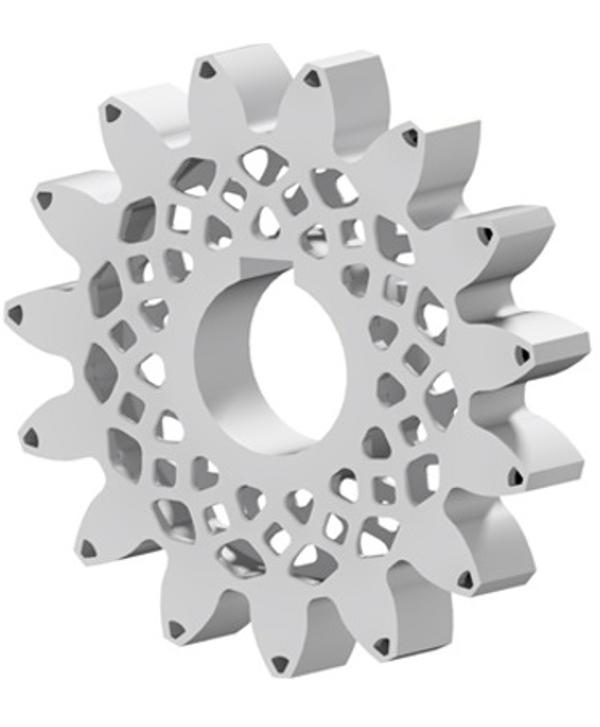
Developing lighter gearboxes for wind turbines: with bionics and innovative sensors
Funding duration:
Start
01.12.20
End
31.05.24
Wind energy plays a key role in the energy transition and is already making an important contribution to German electricity production. In order to achieve the climate targets, the expansion of powerful wind turbines is being driven forward. However, as output increases, so do the dimensions of the turbines, especially the gearboxes, which are key components that require considerable quantities of materials. This increases costs and worsens the carbon footprint of the turbines. In addition, the higher weight of the gearboxes increases the loads on the nacelle and tower, which further increases the material requirements of the entire system.
Previous lightweight construction approaches for gears have mostly been limited to the base body and offer weight savings of up to 45 per cent. This is where the FlexGear project comes in with a comprehensive lightweight construction concept: With bionically inspired structures that extend into the gear rims and innovative manufacturing technologies, the researchers aim to achieve weight savings of up to 65 per cent for gears.
The scientists' main goal is to develop a highly optimised lightweight gearwheel with flexible structures. Their approach is based on bionic design principles that minimise the use of materials while maximising stability. The team is not only looking at the gear wheel base body, but also the gear rims, which will enable them to realise additional weight savings.
Another key element is the inside-sensoring system, which is integrated directly into the gear structure. The researchers use this system to record loads and deformations in real time and transfer the data to a condition monitoring system. This enables the proactive compensation of load peaks, which not only increases operational reliability but also avoids the need to oversize the systems. FlexGear thus aims to improve the service life and efficiency of wind turbine gearboxes while reducing CO2 emissions during both production and operation.
Initially, the researchers developed bionic designs based on natural models such as diatoms. These microorganisms are characterised by their minimal material structures with maximum stability. The ELiSE process (Evolutionary Light Structure Engineering) is used to develop optimised structures that are flexible enough to compensate for load peaks.
To produce the gears, the team uses additive manufacturing processes that enable the realisation of highly complex geometries. This technology also makes it possible to integrate sensors directly into the gearwheel. To this end, the researchers developed an inside sensing system based on thin-film technology. It measures loads and deformations directly inside the gearwheel and transmits the data in real time to a condition monitoring system that recognises and compensates for critical load peaks.
Finally, the team tested the gears on a specially designed test bench under realistic loads in order to check both their structural properties and the functionality of the sensor system. In order to assess the actual mass savings and mechanical load capacity, the researchers compared the demonstrator with conventional gearwheels. At the same time, the bionic design process was automated so that the knowledge gained could be transferred to other applications in the future.

Pultrusion for fibre composites: producing multifunctional lightweight structures
Funding duration:
Start
01.01.21
End
31.12.23
The demands on lightweight structures are increasing: they need to be even lighter, more economical to manufacture and take on additional functions. Fibre composites are ideally suited for this. On the one hand, their mechanical properties open up many fields of application. On the other hand, additional functions can be integrated into these lightweight elements. Just a few lightweight components can fulfil so many technical functions. However, such complex and customised structures cannot currently be manufactured economically in series production, but are instead produced in time-consuming manual work.
The project partners are developing a process to produce multifunctional lightweight structures economically - across all sectors. To do this, they want to use the established technology of pultrusion for fibre composites. Pultrusion means extrusion. This allows continuous fibre-reinforced plastics to be produced efficiently and cost-effectively.
The project team now wants to further develop pultrusion in such a way that both additional materials and electronic components can be integrated into the lightweight structures. The scientists are pursuing two approaches: Firstly, they are developing a mechanically functionalised lightweight profile for rail vehicle construction. The lower vehicle weight can significantly reduce operating and life cycle costs in the transport sector.
Secondly, they are developing sensor-functionalised lightweight construction elements for the rotor blades of wind turbines. These sensor bridges are currently produced manually, with the embroidered strain sensors being processed in a hand laminate. The project team now wants to automate production using pultrusion and ensure mass suitability. The project team then wants to merge the two technologies and thus combine mechanical and sensory functionalisation.
The team integrates metal inserts into the fibre-plastic composites and creates a hybrid layered composite. The inserts act as force transmission or connection points and create additional functionalisation. The components are intended to replace the extruded aluminium profiles in the body of a rail vehicle and significantly increase the degree of lightweight construction while maintaining the same economic efficiency. After optimising the process, the researchers were able to successfully produce several demonstrators. Compared to an aluminium longitudinal beam, they were able to save around 40 percent in weight.
In a second approach, the researchers are integrating strain sensors into the pultrusion process. Their aim is to produce functionalised sensor bridges for wind turbine rotor blades. The sensors recognise overloads and damage at an early stage and have a longer service life. As a result, maintenance intervals and the utilisation period of the turbines can be extended. The team has successfully completed this development and achieved serial production.
To combine the two approaches, the project partners are producing multifunctional profiles for rail vehicle construction by integrating mechanical and sensory functional elements into the manufacturing process. This would further increase the degree of lightweight construction and the condition of the components could be monitored over their entire service life, which would further increase economic efficiency.

Recycling and cleaning plastics: for recyclable battery housings
Funding duration:
Start
01.07.22
Today
10.01.25
End
30.06.25
With the "Green Deal", Europe is aiming to become climate-neutral by 2050. The recycling of plastics, in particular the use of reprocessed plastic waste, known as recyclates, is a key component of this.
Recyclates also play an important role in resource-efficient lightweight construction: the more recycled plastics are used in lightweight components, the more primary raw materials - and therefore CO2 - can be saved.
However, one problem is that conventional mechanical recycling cannot sufficiently break down the material composite. It is unclear whether the shredded material is directly suitable as a recyclate or whether the material composite must be completely broken down.
The researchers are using a high-voltage battery housing to investigate how recyclable battery housings can be manufactured. These housings are crucial for the protection of sensitive vehicle batteries and must therefore fulfil high safety requirements, for example in the event of side impacts and underride protection.
They are part of the vehicle's load-bearing structure and must bear a surface load of up to 500 kg through the battery modules. They also integrate complex functions such as battery cooling.
The project team is investigating ways to make battery housings recyclable and recyclable. The researchers are relying on the new adaptive recycling technology CreaSolv®, which uses solvents to recycle and clean plastics. This technology already enables the recycling of thermoplastic films.
The team is now working on transferring this method to the recycling of lightweight fibre composite structures, i.e. engineering plastics. The researchers are analysing the entire life cycle of a fibre-reinforced plastic battery housing across all stages of the value chain.
They are investigating the production and processing of the material, its ageing in use and the possibilities for recycling it so that it can ultimately be used again in the same component. With the prototype developed, the research team wants to demonstrate that the greenhouse gas-intensive primary plastic can also be replaced by recycled material for sophisticated components for electromobility.

Making cold forming more resource-efficient: digital in-process testing
Funding duration:
Start
01.05.21
End
31.12.24
A large proportion of CO2 emissions are caused by industrial production. Optimised production processes - for example in automotive or mechanical engineering - therefore offer great potential for reducing emissions.
Forming technology, in which raw parts are specifically brought into a different shape without removing material, offers great advantages over conventional production processes, such as machining, in which material is removed from the raw part. In addition to significantly lower CO2 emissions, formed parts also have very good mechanical properties, which makes them more resistant to loads and thus enables smaller designs. Until now, the production of formed parts with tight tolerances has required solutions specially tailored to the components or processes. In order to bring such forming processes into widespread industrial use without special solutions, generally applicable test methods are needed that guarantee the required quality even at very high production cycles. This is where the GUmProDig research project comes in.
The researchers' aim is to use digitalisation to make cold forming more energy-efficient as a manufacturing process and to significantly improve the accuracy and surface quality of formed parts. This makes it possible to replace energy- and material-intensive machining in many areas. The project partners have calculated that the switch to this more resource-efficient manufacturing process and the reduction in rejects due to the shortened start-up phase of the forming process thanks to inline testing technology will already save large amounts of CO2.
However, the researchers expect the greatest contribution to CO2 reduction to come at a later stage: thanks to the continuous inspection and marking-free identification of the components, costly and resource-intensive recalls - which are particularly common in the automotive industry - can be prevented. According to the project partners' forecasts, this should enable total CO2 savings of more than 600,000 tonnes per year.
The project partners are developing an innovative free-fall inspection system for in-process testing of all manufactured components. The system enables them to precisely record many different quality parameters - such as geometry and surface quality. These parameters can be individually assigned to individual components together with other process monitoring data.
The components are transported individually, but without pre-orientation, via a conveyor belt into a measuring sphere and recorded in free fall from all directions using 16 cameras. Various image processing algorithms, some of which are AI-based, inspect the parts at up to three parts per second with an accuracy of a few micrometres. The project team also uses the individual surface structure of the parts at a defined point as a fingerprint, which can be used to trace them later.

Making particle foams more sustainable: Process energy-efficiently, enable recycling
Funding duration:
Start
01.12.20
End
31.05.24
Particle foams such as expanded polypropylene (EPP) are key materials for lightweight construction. In the automotive industry in particular, they help to reduce vehicle weight and thus lower fuel consumption and CO2 emissions. However, traditional production using hot water vapour is very energy-intensive. Only around one per cent of the energy is used for welding the particles, the rest is lost unused.
At the same time, the recycling of EPP material is not yet sufficiently realised. At the end of its useful life, the material is usually thermally utilised. A genuine circular economy is not yet possible, as the processing of recycled material impairs the quality. This is where the GePart research project comes in: The team wants to improve processing and close the material cycle of EPP sustainably.
The GePart project team is pursuing two key objectives: developing an energy-efficient processing technology and increasing the proportion of recycled material. With the help of radio frequency (RF) technology, the researchers want to weld EPP without water vapour in the future. This saves up to 90 per cent energy, as the heat is generated directly inside the foam beads. At the same time, the scientists want to increase the proportion of recycled EPP material to between 50 and 70 per cent. To achieve this, the project team is further developing the recycling processes and precisely analysing the material properties. The aim is to optimise the quality of recycled EPP so that it meets the requirements for series production.
In order to industrialise the RF technology for EPP, the researchers have further developed the process at laboratory level. In doing so, they were able to confirm the advantages of RF technology over vapour-based processing: uniform heating, minimal energy loss and the use of cost-effective plastic tools. At the same time, the team developed new recycling strategies for high-quality reprocessing of EPP material after its utilisation phase.
The scientists analysed the degradation behaviour of the material along the cycle and optimised the processes for removing impurities. Comprehensive tests showed that a recyclate content of up to 70 per cent is realistic without compromising the quality of the components. An accompanying life cycle assessment confirmed the successes: 15 per cent energy savings during production and 25 per cent fewer CO2 emissions thanks to the use of recycled material.

Reusing aluminium scrap in cars: Focus on recycling and material sorting
Funding duration:
Start
01.07.21
End
30.06.24
Sustainable lightweight materials are crucial to reducing the environmental impact of mobility and increasing resource efficiency in the industry. Manufacturers are increasingly using aluminium, especially in highly stressed components such as axle components, wheels, body structures or high-voltage battery housings, as it is significantly lighter than steel, for example, and can therefore significantly reduce CO2 emissions during the use phase. However, aluminium production is not only expensive, but also releases a lot of CO2.
One sustainable option is to recycle aluminium. The use of secondary aluminium is not only sustainable, it also pays off for companies. By analysing and optimising the digitalised process chain, the researchers are increasing cost efficiency, for example by adjusting the alloy composition or the forming processes. In this way, lightweight components based on secondary aluminium can be brought into widespread industrial use, for example in mid-range vehicles or aircraft.
In the Green-AL-Light research project, a broad-based consortium is investigating how aluminium from car scrap can be recycled and reused. To this end, the project partners are looking at the entire process chain, starting with the recycling of the cars and the sorting of the end-of-life (EoL) scrap materials. This is followed by the development and testing of new secondary wrought alloys, casting of the alloys with the highest possible secondary aluminium content, processing into components by extrusion and / or forging and testing for use in cars. To ensure that the holistic analysis is successful, the scientists are building up the individual steps in a cross-location and digitally networked manner. They cover all stages of the process chain. The interdisciplinary team aims to demonstrate that EoL material can also be used for highly stressed aluminium components and can be used cost-effectively.
In order for the secondary aluminium to be reused, the EoL scrap must be reliably separated by type and alloy. To this end, the project team is further developing the sorting technology using the laser-induced breakdown spectroscopy (LIBS) process. Among other things, the project partners are investigating whether, and if so, in what quantity, previously undesirable by-elements are contained in the recycled material. This enables them to subsequently adapt and optimise the composition of the alloy.
By reusing EoL scrap in high-quality aluminium alloys, the material cycle is closed. This conserves resources and reduces CO2 emissions. Using the example of an aluminium forged wheel from Audi, the project partners calculate a potential saving of at least half the CO2 compared to a wheel made from primary aluminium. In addition, the increased use of secondary aluminium results in less waste that is problematic to dispose of, such as red mud.
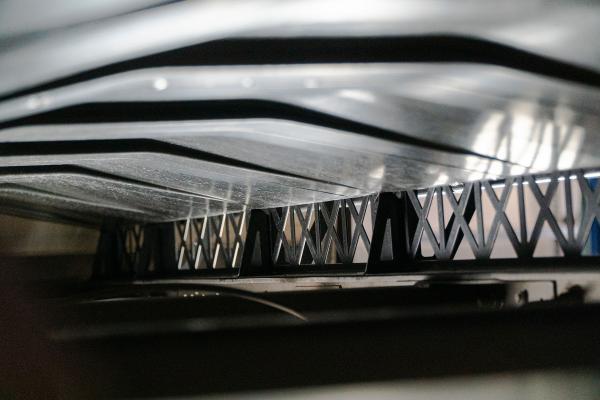
Utilising hybrid materials: Lightweight trunk floors for commercial vehicles
Funding duration:
Start
01.06.21
End
30.11.23
Lightweight construction is one of the key technologies for sustainably reducing CO2 emissions in the transport sector. It offers enormous potential, particularly in the area of light commercial vehicles, which make up two thirds of the vehicle fleets in the courier, express and parcel service (CEP) sector. The floor of such vehicles often consists of numerous individual parts made of heavier materials such as wood or metal. This construction method is not only costly and time-consuming, but also difficult to optimise.
One challenge is the use of modern materials such as glass fibre reinforced plastics. Although these materials are light and resilient, they require special processing and manufacturing techniques to make them usable for vehicle construction. The integration of functional elements such as lashing points or screw connections poses additional technical challenges. This is where the HyDuty research project comes in, with the aim of overcoming these hurdles through innovative approaches.
The HyDuty project aims to develop a new box body floor assembly for light commercial vehicles. This floor is made from glass fibre reinforced plastics and hybrid materials. The modular design allows flexible adaptation to different vehicle types. The integral design takes centre stage: It combines the substructure and floor panel in one compact unit.
This eliminates many assembly steps, saving time and costs. In addition to material savings, the focus is on reducing CO2 emissions over the entire service life of the vehicles - from production and operation through to recycling. The project aims to show that lightweight construction can simultaneously reduce weight, emissions and costs without compromising functionality.
The project team first defined the requirements for the floor assembly. Data from simulations and real test drives are used to map the typical loads in the everyday life of a CEP vehicle. On this basis, prototypes are created that are manufactured from glass fibre-reinforced plastics using the extrusion process.
This process makes it possible to integrate functional elements such as lashing points or fastening elements directly in a single production step. This is followed by validation: the structure is tested on a test bench and in real-life use. The team checks whether the simulated loads correspond to the real loads. The results are used to optimise the design and manufacturing processes.

Automatically detect damage: intelligent battery protection system for electric cars
Funding duration:
Start
01.12.20
End
30.11.23
For the energy transition to succeed in the long term, it is crucial to gradually electrify the transport sector. One of the biggest obstacles is currently the comparatively short range of electric vehicles. Lightweight construction offers considerable potential here, as it can help to reduce the moving masses and thus increase the vehicle range.
The battery protection structure of an electric vehicle is located underneath the traction battery and protects it from mechanical loads such as stones thrown up from the road. Up to now, it has usually been made of thick-walled aluminium, steel or titanium and is therefore heavy and expensive.
In addition, there is currently no way to automatically determine the extent of damage after a mechanical load without removing components, meaning that a visit to the workshop and possibly a replacement of the entire structure may be necessary even on mere suspicion.
In the I-Detekt project, the project partners want to develop an intelligent battery protection system for electric vehicles that automatically recognises damage to the battery protection structure, but also to the battery itself.
The project team wants to develop a battery protection structure made of a glass fibre-reinforced plastic with integrated sensors. The latter should automatically recognise and classify relevant damage. Thanks to the lower component weight, resources can be saved both during production and throughout the entire utilisation cycle. The integrated sensor technology also leads to further significant savings in material resources, as the battery protection and the battery itself only need to be replaced if there is actually a defect.
The team wants to test and verify the structures both virtually - using digital twins - and experimentally in order to enable subsequent industrial series production. This is made possible by the broad technical composition of the consortium across the entire supply chain. In the future, the intelligent battery protection system should also be transferable to other sectors and applications, such as rail vehicles or mechanical and plant engineering.
The project partners anticipate potential greenhouse gas savings of up to 440,000 tonnes of CO2 equivalent. This calculation is based on the VW Group's annual production of electric vehicles from 2025 onwards, with an average mileage of 200,000 kilometres.
The research result shows that the detection of damage levels via the underbody protection system is possible in principle. The technical challenges such as component complexity and differentiation of the damage stages now need to be clarified in more detail, as do the potential economic and ecological issues.

Optimising die casting for electric cars: with innovative aluminium alloys and magnesium
Funding duration:
Start
01.01.21
End
31.12.23
Since the beginning of motorised transport, cast components have been an elementary component of vehicle technology. German foundries lead the global market with their highly developed die-cast parts for combustion engines, transmissions and structural components. In order to secure this technological leadership in the face of the electromobility transition, companies must now optimise their materials and processes for use in electric cars. To this end, the project team is utilising various lightweight construction technologies along the value chain. The partners cover the entire automotive production process - from material, component and process development to supply and use in the car.
The project partners want to optimise the materials, construction methods and die casting processes so that components can be produced with lower weight, lower costs, improved quality and reduced CO2 emissions. On the one hand, the project team is developing new aluminium die-casting alloys with a high proportion of recycled material, which exhibit the required properties directly after die-casting without any further process steps. These innovative alloys have better mechanical properties, make the components lighter and do not require energy and cost-intensive heat treatment. Compared to conventional aluminium solutions, they make components up to 20 percent lighter, which also saves costs and CO2 emissions in the application.
The researchers also want to develop magnesium die-cast parts for the electric drivetrain. Magnesium is not only lighter than other metals, but also has significantly better damping properties, which are advantageous in the electric drivetrain to reduce disturbing noises.
For the casting of magnesium components, the project team is endeavouring to raise the component quality in the cold chamber die casting process to the level of today's hot chamber processes by using so-called vacural technology. This makes it possible to produce highly stressed or large magnesium components with low reject rates and very good material properties.
The researchers are combining their findings in the construction of a representative part from the electric drive train. For example, they are developing the bearing cover of a gearbox module, which is ideally suited to demonstrating the improved mechanical properties with its bearing seats and diverse local stiffening ribs. Thermal conductivity and vibration damping also play a major role here. The gearbox cover is developed, manufactured and tested as a variant made of secondary aluminium and magnesium. The application with its material variants is selected so that the research team can transfer the knowledge gained to other components of the electric drivetrain or the vehicle structure.

Building fertiliser spreaders more sustainably: lightweight and modular support structure
Funding duration:
Start
01.01.21
End
30.04.24
The growing global demand for food and renewable raw materials requires increasingly intensive farming. This is accompanied by problems such as increasing soil compaction, which is also caused by increasingly heavy machinery. Conventional fertiliser spreader booms made of stainless steel structures are already so optimised in their lightweight steel construction that no major weight savings are possible. With innovative technologies and new material approaches, lightweight construction can help to make machines lighter and more efficient and thus make agriculture more sustainable.
The LE²GRO project aims to develop a near-series, weight-reduced and modular support structure for fertiliser spreader booms. By using innovative lightweight construction technologies in the form of braided fibre-thermoplastic composite profiles, heavy and cost-intensive stainless steel tubes are to be replaced. This enables comprehensive manufacturing, structural and functional integration while avoiding cost-intensive post-processing steps. The scientists are not only striving for technological innovation, but also for an economically viable solution for the agricultural machinery industry.
The researchers use the continuous blow moulding process for the production of fibre-reinforced thermoplastic hollow profiles and develop a digital tool for the automated design and dimensioning of the supporting structure. They are developing load-appropriate profile connections and innovative braided node structures and implementing them as prototypes. The modularisation of the supporting structure enables rapid adaptation to different application scenarios and helps to increase efficiency when spreading the fertiliser. Integrated sensor technology also enables continuous monitoring and optimisation of the agricultural machine.
In addition, the researchers are further developing process chains to ensure the economical production of functional load-bearing profile structures and to guarantee consistent quality monitoring. The innovative approach of the multi-material support structure design promises not only a significant reduction in component complexity, but also improved competitiveness for the German agricultural industry as well as more sustainable agriculture by reducing soil compaction and optimising fertiliser application.

Glass-foil roofs save resources: modular translucent roof system
Funding duration:
Start
01.07.21
End
31.12.23
Glass roofs span railway stations, leisure pools and shopping arcades. This translucent overhead glazing is usually made of several panes of insulating glass. What appears light and bright is actually heavy and consumes a lot of resources. This has a detrimental effect on the overall construction, material transport and installation. Lighter film-based materials, on the other hand, are still being trialled today. An integrated overall system is missing.
The project partners are developing an innovative, lightweight and modular lightweight construction system for translucent roofing. To this end, they are combining a modular glass-foil system with an inner roof made of a mobile, translucent and IR-reflective fabric. The modular system consists of ETFE film covering (ETFE: ethylene tetrafluoroethylene copolymer) and toughened safety glass. ETFE is now permeable to up to 95 per cent of light. These building envelopes are becoming increasingly important in architecture in particular, as the materials are better characterised and it has been possible to overcome production-related obstacles through bonding and welding, for example. Prominent examples of the use of ETFE are the "Allianz Arena" in Munich and the "Water Cube" in Beijing.
The project team has calculated that the translucent roof system made of glass and foil will weigh 75 per cent less than conventional roof coverings with triple insulating glass. This results in CO2 savings of up to 29.2 kg per square metre of surface area for the Light-Light-Roof lightweight construction system. In horticulture and the plant trade, the project partners are forecasting a CO2 reduction of over 1.4 million tonnes in ten years for Europe-wide "production under glass". In addition, there are further, as yet unquantifiable savings in building construction: for example, architects could design slimmer and lighter buildings, as the load-bearing structure would have to bear significantly less weight. In addition to the plant trade, Light-Light-Roof is also interesting for other markets, such as the construction of shopping arcades, railway stations, leisure pools, hotels or building facades.
The project partners create a prototype that they test under real conditions. In a representative environment: in the "Altmarktgarten Oberhausen" rooftop greenhouse, they are investigating the glass-foil roof in various material combinations on a roof area of 40 m2 in year-round operation. The "Altmarktgarten Oberhausen" is a building-integrated rooftop greenhouse with its own research and development area. It is a flagship project of the federal programme "National Urban Development Projects" and is therefore attracting a great deal of attention. In addition, the system is being demonstrated and analysed for use on façades at the Fraunhofer UMSICHT site.
The project team has installed a sensor network in the rooftop greenhouse in order to investigate and visualise the light and climate management of the overall system. In addition to visualising the entire database, various sub-visualisations were created to provide insights into the temperature and humidity behaviour of the individual levels. In addition to a clear data evaluation, this visualisation is primarily used for demonstration purposes. Interested parties can clearly and intuitively understand the operating behaviour of the system when environmental parameters change, such as the opening and closing of the vents. The project team is particularly focussing on the expanding market for production systems located in urban areas.

Reducing CO2 emissions in logistics: plastic large load carriers in fibre composite construction
Funding duration:
Start
01.12.21
End
30.11.24
Companies use so-called large load carriers for the worldwide transport of goods and vendor parts. Thanks to their customised design, they offer special protection and have plenty of storage space - especially for heavy and bulky goods, machine parts or workpieces. Components for the automotive industry in particular are transported worldwide in these containers. An estimated 2.5 million large plastic load carriers are used in the automotive sector alone. For heavier goods and supplied parts, lattice boxes made of steel are currently used. Their disadvantages: The rigidly constructed boxes have a high dead weight and cannot be folded to save space when empty. This results in high CO2 emissions in logistics and transport, as the utilisation phase accounts for the majority of greenhouse gas emissions from large load carriers.
The project team is optimising comparatively lightweight plastic large load carriers so that they are more stable and at the same time more flexible in use in order to reduce greenhouse gas emissions in logistics and the environmental impact of the production and recycling of large load carriers. To this end, the researchers are developing a fibre composite construction method suitable for large-scale production for optimised plastic-based large load carriers. With these thermoplastic-based sandwich constructions, they want to achieve a better mass-performance ratio in order to further increase the payload and load capacity of plastic-based large load carriers. The volume of the boxes can be minimised many times over for empty transport by folding them up and stacking them on top of each other. This saves CO2, as significantly more boxes can be transported in one lorry. The lightweight sandwich construction also extends the service life of the transport containers. The team also wants to reduce the repair rate through an optimised design and functional integration - with an increased payload. The researchers want to recycle the fibre-reinforced thermoplastics and recycle them in the large load carrier system or make them available to other plastics processing industries.
For the innovative lightweight carrier box, the researchers combine two fibre-reinforced cover layers with a core material that has already been successfully used. This enables an optimised ratio between mechanical properties and component weight, with industrial production and recyclability. Compared to monolithic construction, they can achieve significant weight savings of up to 70 per cent - while maintaining the same mechanical performance, or increase the performance for higher payloads in large plastic load carriers. The project team uses thermoplastic, meltable plastics for the core and the cover layers in order to be able to manufacture the sandwich panels in continuous production processes. Further innovation paths are conceivable in the future by applying the manufacturing process developed in the project to other components.
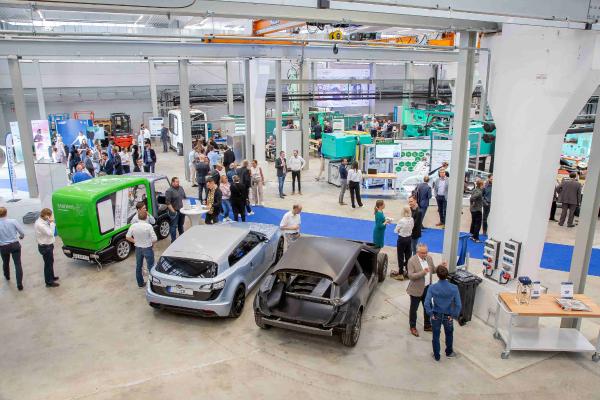
Reducing resource consumption by 80 per cent: production of lightweight structures
Funding duration:
Start
01.12.20
End
30.11.24
In order to drive forward the transition to a climate-neutral industry, new technologies and processes must be quickly put into practice - including in lightweight construction. This is where the National Lightweight Engineering Validation Centre (LEIV) at the Technical University of Dresden comes in. The project is making a significant contribution to accelerating the transfer from research to the real economy.
To this end, the LEIV is organised as an independent and open research platform with around 1,500 square metres of test space. In addition to large companies and original equipment manufacturers, small and medium-sized enterprises (SMEs) in particular also benefit from the opportunity to realise demonstrations on an industrial scale. This can significantly accelerate the practical transfer of research results. The start-up funding for the centre is based on the TTP LB-funded METEOR project.
METEOR is the first in a series of research projects, the results of which are intended to help reduce CO2 in the production of sustainable lightweight structures. The aim is to reduce resource consumption in the production of high-performance lightweight structures by 80 per cent in real terms by 2030 and to create a largely environmentally neutral production network. To this end, material cycles are to be established and an end-to-end virtual process chain, the continuous balancing of resource efficiency and the consistent use of renewable energies within the process network are to be implemented.
Initially, the development and construction of a solar thermal mould heating and cooling system and the establishment of a temperature control cascade will form the infrastructural basis for the LEIV. The researchers are using the process chain of light metal die casting, plastic injection moulding and mechanical joining, which is particularly relevant for lightweight system construction, to demonstrate the considerable CO2 saving potential that can already be realised.
The project partners are demonstrating new approaches to validate and optimise the resource efficiency of lightweight structures - for example in solar-assisted temperature control, the inline simulation of production processes or the robot-assisted joining of composite structures. They are developing the process chain for manufacturing a hybrid structure into a linked process network - with intelligently controlled process management and coordinated technologies. In doing so, the project team collects extensive data and thus enables an improved assessment of resource efficiency in order to quantify potential CO2 savings and demonstrate the added value of modern process networks.
One result of the project is a new market-ready installation tool that installs threaded inserts in a process-monitored manner. During the entire assembly process, sensors on the nose piece monitor the correct installation of the HELICOIL thread insert. In addition, the angle of rotation and torque-controlled installation enables the thread insert to be inserted to a precise depth.

Advancing lightweight construction in shipping: Expansion of the MariLight network
Funding duration:
Start
01.07.21
End
31.12.24
The maritime industry can make a decisive contribution to reducing CO2 emissions. Lightweight construction - alongside alternative propulsion systems and new fuels - is a key lever for this. Innovative lightweight construction technologies enable shipbuilders to compete in the upper price segment of the market with highly complex special ships.
Thanks to lightweight construction, shipowners can reduce the draught of their ships or increase the payload so that the ships are better utilized. On the one hand, strengthening maritime lightweight construction makes the national industry competitive. On the other hand, innovative lightweight construction technologies can improve the climate and environmental balance of maritime transport.
The Center of Maritime Technologies has founded the national maritime lightweight construction network MariLight.Net in order to exploit the potential of lightweight construction in the maritime sector and bring the technology into widespread industrial application. The aim is to further intensify the exchange of knowledge within the industry and facilitate cross-industry technology transfer. This is because the maritime industry is extremely heterogeneous: it manufactures various product sizes and types using different materials. This means that everything is involved, from small pleasure craft to cruise ships, from series products to special ships, and from steel to fiber-reinforced plastics (composites).
In the MariLightCluster project, CMT is further developing the MariLight network. The focus is on technology development and transfer. MariLightCluster supports the participating companies and institutions in establishing strategic cooperations and thus promoting innovations in maritime lightweight construction.
MariLight supports companies in implementing lightweight construction applications, strengthening their competitiveness thanks to innovative unique selling points and utilizing the potential of lightweight construction to achieve emission savings.
The team is developing a roadmap that demonstrates the potential of maritime lightweight construction for more sustainable shipping. The roadmap takes up the state of the art and identifies gaps in knowledge and the need for action, such as necessary research projects or regulatory adjustments.
At the same time, MariLight is driving forward the development of international regulations that can simplify the widespread use of innovative lightweight materials. This is done, for example, through involvement in committees of the International Maritime Organization (IMO) and the Strategy Advisory Council of the German government's Lightweight Construction Initiative.
At the same time, MariLightCluster provides a platform for a regular cross-industry exchange of knowledge and experience. The team organizes specialist events to promote technology transfer with other industrial sectors such as aviation, rail vehicle construction and construction.

Recycling plastics: pioneering cascade model for 3D printing in lightweight construction
Funding duration:
Start
01.01.22
End
31.12.24
Additive manufacturing enables companies to produce high-quality everyday products, some with complex functions, from a single material in a short space of time. This allows them to significantly reduce material and energy consumption compared to conventional processes. However, the reuse of the materials used to create new raw materials is still unresolved in 3D printing. For the design, manufacture and recycling of these products, the project team has developed a cascade model that interlinks medicine, sport and lifestyle. This combines powder bed-based additive manufacturing, extrusion-based additive manufacturing and conventional injection moulding.
The researchers' aim is to recycle the materials used in additive manufacturing processes as completely and repeatedly as possible so that they become part of a cross-industry ecological circular economy. The scientists are focussing on polymers, i.e. plastics, and their application in medical, sports and lifestyle products. These include, for example, midsoles for running shoes, rucksack pads, shin guards and prostheses. These products must be customised to individual requirements so that they contribute to an improved quality of life in everyday life.
The researchers are also using demonstrators to calculate how many greenhouse gas emissions can be saved thanks to the cascade model developed. For this forecast, the project team is not only looking at the respective materials and production processes, but also at recycling and the ecological impact, such as by-products and waste.
The cascade begins with the additive manufacturing of products that need to be of outstanding quality for individualised applications in medicine. The researchers use the powder bed-based processes of laser sintering, multi-jet fusion and high-speed sintering for this purpose. If the products can no longer be used, the material is recycled: depending on its condition, it is processed again in the powder bed or goes on to material extrusion. This can result in products for sports or lifestyle - i.e. areas in which qualitative requirements for material properties are easier to fulfil. In this process, the plastic can be reused until it has finally worn out. It is then available for injection moulding in mass production.

Resource conservation and efficiency: multifunctional lightweight vehicle centre console
Funding duration:
Start
01.09.21
End
31.08.24
In many applications in the mobility sector, the aim is to combine lower weight with the same or increased functionality. In addition, sustainability issues are becoming increasingly important against the backdrop of increasing environmental and climate pollution. Sustainable lightweight construction technologies can make a decisive contribution to the resource, energy and transport transition with innovative solutions.
In the NaMiKoSmart project, researchers are developing a weight-reduced and multifunctional vehicle centre console that combines economic potential, climate protection and resource efficiency. To this end, they are combining various innovative lightweight construction technologies. The aim is to use the component as an example to demonstrate the possibilities for cross-industry utilisation of sustainable materials and production-ready process technologies. The research results should contribute to effectively reducing the weight of components in various industrial sectors without restricting functionalities.
The project team aims to demonstrate how sustainable natural fibres and the innovative space-winding process, "xFK in 3D", can be used to produce lightweight yet high-strength and rigid truss structures with minimal waste. In addition to high resource efficiency due to the reduced waste of the composite material - of a maximum of one per cent - large amounts of CO2 are to be saved throughout the entire life cycle of the bio-based, completely recyclable material. The project partners also want to integrate various additional functions with "Smart Textiles".
With "xFK in 3D", the researchers are using a cost-effective and flexible fibre composite technology for the three-dimensional winding of various fibre materials such as nylon, carbon, glass or basalt fibres. The hybrid or multi-material approach is characterised by a digital process chain that is being continuously developed. The fibre-reinforced plastics are wound based on calculations and simulations and can be specifically placed in the direction of the force and load paths. This allows the researchers to significantly reduce material and energy consumption and cut CO2 emissions.
The scientists are also focussing on the use of smart textiles. Linking these functional fabrics with "xFK in 3D" not only enables significant weight savings, but also the integration of new design elements, haptics, heating functions, sensors and lighting options.
When selecting materials and production processes, the project team relies on comprehensive analyses, such as the "Sustainability Value Analysis". This management tool is used to identify and evaluate ecological and economic sustainability criteria at an early stage. In this way, weak points in the process chain are recognised at an early stage with regard to their ecological and economic sustainability aspects and can be taken into account during development.

Producing hybrid lightweight structures: automated process chain with quality assurance
Funding duration:
Start
01.04.21
End
30.09.24
Lightweight construction plays an important role in increasing the efficiency of vehicles. It enables a higher payload and offsets the additional weight through electric drives and energy storage. At the same time, it helps to conserve resources - whether through lower material consumption, more efficient production, longer use or better recycling.
Metallic materials such as steel still dominate in vehicle construction, but their high strength is accompanied by considerable weight. Alternative lightweight construction solutions have so far only been used to a limited extent due to high costs or technical hurdles. This is where the NeLiPro project, short for Next Level Lightweight Production, comes in.
The researchers investigated ways to produce hybrid fibre composite components that are lighter and whose highly stressed components can also be manufactured in large quantities in a resource-efficient manner - while at the same time offering a wide range of variants. With a modular system, the range of applications for fibre composite lightweight construction is to be extended to various applications, particularly in commercial vehicles and rail transport. Through energy-efficient manufacturing processes that consume up to 80 per cent less energy and by reducing the weight of the vehicles, the researchers want to significantly reduce CO2 emissions - both in production and during use. Digital methods for process monitoring and quality assurance should also ensure the scalability of production. Furthermore, recycling strategies are to be developed to make lightweight construction economically and ecologically viable in the long term.
The researchers developed and validated an integrated production chain for lightweight components. A key innovation is the automated production of the fibre composite components, which are connected to metallic load introduction structures. New manufacturing and joining processes ensure precise and highly resilient connections of the components, while digital methods for error detection and data management further optimised the process chain. For process-integrated quality assurance, the researchers used, among other things, an inline microwave inspection system that enables the early detection of quality deviations during the production of the fibre composite structure. The researchers integrated recycling strategies at an early stage in order to minimise waste and facilitate recycling. Finally, the scientists assessed the environmental sustainability of the new processes and products by means of a comprehensive life cycle analysis.

Air-coupled ultrasonic testing: damage-free and flexible testing of lightweight components
Funding duration:
Start
01.02.21
End
31.01.24
The safety inspection of lightweight components is a key challenge in the industry. Current methods use liquid coupling agents such as water to transmit ultrasonic waves into the components. However, these agents have negative effects: They can damage sensitive materials such as honeycomb core structures or foams, increase maintenance costs and make it difficult to inspect complex geometries, especially for components with one-sided access.
Conventional air-coupled ultrasonic methods are technically limited: Single-channel systems do not allow precise control of the sound field and are unsuitable for complex applications. The PALUP project specifically addresses these weaknesses. The team developed an innovative testing technology that does not require any coupling agents at all, yet offers maximum testing accuracy and can be flexibly applied to different component geometries.
With PALUP, the project team is pursuing the goal of developing a demonstrator for an air-coupled phased array system that works entirely without coupling agents. With this technology, sound fields can be electronically focussed, swivelled and scanned. This opens up new possibilities for testing complex geometries and areas that are difficult to access.
The researchers want to create a solution that not only overcomes the existing limitations of air-coupled ultrasound technology, but also transfers the precision and flexibility of phased array technology to a non-contact method. In the long term, this innovation should make lightweight construction applications safer and more sustainable, particularly in safety-critical areas such as aerospace or the automotive industry.
The researchers have combined their expertise in sensor development and test device integration to develop a demonstrator with novel airborne ultrasonic sensors. They used cellular polypropylene, a material with piezoelectric properties that does not require any matching layers and is ideal for the transmission of ultrasonic waves in air. The sensors were designed as phased arrays to enable precise electronic control of the sound fields.
At the same time, the team developed multi-channel transmitter and receiver electronics as well as specialised software for data acquisition. With this system, the researchers were able to carry out tests without mechanical movement or coupling devices. The result is a pioneering technology that enables flexible, precise and safe non-destructive testing of lightweight components and creates the basis for a broad industrial application.

Faster, cheaper and more sustainable: modular bridge construction with carbon concrete
Funding duration:
Start
01.08.21
End
30.04.24
Around 7,400 bridges on German motorways and federal roads are part of the BMDV's modernisation network and are to be renovated or replaced by 2030. To minimise disruption to traffic, short construction times are essential. Modular construction with non-metallic reinforcement offers an innovative solution here: the various components for the bridge are completely prefabricated in the factory, delivered to the construction site and then connected on site.
The advantages of modular bridge construction with non-metallic reinforcement are manifold: industrially manufactured components are more precise and slimmer. In combination with corrosion-resistant reinforcement, this saves concrete and emits less CO2 during production and transport. The scope and size of construction sites as well as the construction time on site - and thus congestion times caused by construction - can be significantly reduced. As the pollutant emissions of a construction project correlate directly with the construction time, the impact on the climate and environment is further reduced.
As the connection of the individual modules is designed to be reversible, they can be replaced or removed in the event of damage without having to completely rebuild the structure. When dismantling, the individual elements could be reused or recycled more easily in future to make the entire life cycle more sustainable.
In an international comparison, modular construction methods are not yet very widespread in Germany. This is less due to its feasibility than to the narrowly defined standardisation. The project team is therefore developing and testing a pilot system. The researchers are building the prototype for a road bridge on a true-to-original one-to-one scale and are liaising closely with the approval authorities.
The findings from bridge construction can be transferred to many sectors of the construction industry - from building construction to the energy industry.
The researchers manufacture the prototype completely in the factory and then join the individual carbon concrete components together on the construction site. The project team wants to achieve this so-called joining by means of pre-stressed dry joints. This means that the prefabricated parts must be manufactured very precisely so that they fit together exactly and static friction is activated. This prevents the individual elements from sliding apart. The outstanding advantage is that the assembly time for the superstructure on the construction site can be reduced to just one working day. Afterwards, the structure is immediately fully load-bearing, as no in-situ concrete has to harden. - This extremely short construction time was demonstrated during the project.
The project partners from industry and science are testing the system under real conditions on a federal highway: they are integrating the bridge prototype into a temporary bypass at a bridge construction site near Freiberg in Saxony. They are exposing the system to the stress of real road traffic for around a year. On 19 September 2023, the structure was put into operation following a load test. With the accompanying metrological monitoring, they want to prove the reliability of the modular design and thus initiate normative adjustments. At the end of its service life, the project partners will examine the bridge in the laboratory and check whether it can be reused at another location.

Processing fibres efficiently: sustainable seating systems for vehicles
Funding duration:
Start
01.11.20
End
31.10.23
Continuous fibre-reinforced thermoplastic fibre composites are among the most innovative materials in lightweight construction. Their exceptional material properties, such as high strength and low weight, offer enormous potential for a climate-friendly industry. However, their industrial use has so far been limited, as high material costs and cutting rates make widespread use difficult. This means that considerable opportunities for conserving resources and reducing CO2-emissions remain untapped.
The aim of RESOLVE is to overcome these hurdles through new technologies and optimised manufacturing processes. The researchers have optimised the fibre orientation of the continuous fibre-reinforced thermoplastic fibre composite materials so that they are ideally prefabricated for specific loads. Specifically, they have designed a modular seating system for trams to demonstrate the potential of these materials. These seats are particularly light, stable and resource-efficient. The project also aims to develop new bionic design approaches that can be used in various industries such as automotive, aviation and rail transport. This will enable a broad industrial application.
The researchers are using what is known as effiLOAD technology. This makes it possible to place fibre materials in a "roll-to-roll" process in such a way that they follow the load paths precisely. As a result, significantly less material is lost, while efficiency and product quality increase at the same time. The project team is further refining this technology and combining it with bionic principles. The focus is on a complete process chain, from the manufacture of semi-finished products to component production and quality assurance. The tram seat concept serves as an application example to demonstrate the potential of the technology in a real product.

Reducing emissions in car production: with digital twins and recycled aluminum
Funding duration:
Start
01.04.23
Today
10.01.25
End
31.03.26
The automotive industry is facing the challenge of making its production more climate-friendly. Aluminum in particular contributes significantly to the CO2 footprint of cars due to its energy-intensive manufacturing process. In order to reduce emissions, recycled aluminum - so-called secondary aluminum - will be increasingly used in the future. Compared to primary aluminum - i.e. aluminum produced directly from the raw material for the first time - significantly less energy is required in the production of secondary aluminum. The researchers in the S3-ALU project want to exploit this savings potential.
The aim of the project participants is to replace primary aluminum in automotive production with secondary aluminum without losing the advantageous properties of the material. They want to use simulations to evaluate the quality and sustainability of the recycled materials. The use of secondary aluminum is intended to significantly reduce the CO2 footprint per vehicle and promote sustainable lightweight construction.
The researchers are developing and using a digital twin to model different compositions of recycled aluminum. The virtual representation depicts the properties of the recycled aluminum and evaluates the suitability of the available aluminum scrap of different qualities for material production. Thanks to the digital twin, the project partners can test different material variants in a time and resource-saving manner without having to carry out numerous physical experiments. This allows them to determine how high the proportion of recycled aluminum can be without compromising the material quality. In addition, the components can also be evaluated in terms of their carbon footprint.

Lightweight in steel construction: end-to-end digitalised production and testing chain
Funding duration:
Start
01.05.21
Today
10.01.25
End
01.04.25
Offshore wind turbines stand on a huge support structure up to 60 metres high, the greater part of which remains hidden below the waterline. Today, a single steel pile, known as a monopile, is often used. Up to 2,000 tonnes of steel are welded together for this purpose - the production of which releases large quantities of CO2.
The tonnage during transport and the amount of CO2 released during steel production is significantly lower if more delicate support structures are used instead of the monopile. However, these lightweight structures, known as jacket foundations, pose a challenge in terms of production technology, meaning that potential CO2 savings have not yet been realised on an industrial scale.
This is mainly due to the very complex weld seams: Today, the jacket foundations are usually welded together manually and later transported to their place of use using special ships. Tolerances in manual production and high safety requirements necessitate a conservative design, i.e. thick-walled components are used.
The aim of SmartWeld is to make the use of lightweight construction techniques possible with an end-to-end digitalised production and testing chain in the construction of foundations. To achieve this, the welding process for the complex seams on the supporting structures is to be adapted so that it can be better automated. If this is successful, the seams will also be more durable. The structures could also be manufactured with thinner walls. They would therefore use less steel and thus save CO2.
With an average 12-megawatt system, around 20 percent of the weight and therefore 400 tonnes of steel could be saved compared to a monopile. This corresponds to around 800 tonnes of CO2. By optimising the design of the weld seams and making savings in the energy-intensive welding process itself, the proportion of CO2 in production could be reduced even further. For a wind farm with 100 turbines by a total of more than 100,000 tonnes.
To ensure that the new production technologies can later be utilised in industry as quickly as possible, the researchers are working as practically as possible. The industrial partners in the research project are developing demonstration systems suitable for series production under real manufacturing conditions. In this way, the research results can later be transferred like a "blueprint" to other areas of steel construction in which large-format structures such as bridge constructions are manufactured.
As part of the project, several demonstrator nodes have already been produced, which were then subjected to various fatigue tests - accompanied by simulations of crack development and crack progression. Trials to automate the welding processes have already significantly increased the production speed.

Reducing the carbon footprint at the material level: Albasia wood for electric cars and lifts
Funding duration:
Start
01.09.21
End
31.08.24
Lightweight construction is crucial to making vehicles more sustainable: The components weigh less and material is saved. This improves resource efficiency and reduces greenhouse gas emissions - not only during production, but also when the lightweight components are later used. Companies are increasingly using hybrid materials that combine different functions and are therefore particularly efficient. However, these materials are usually difficult to recycle and often have a negative carbon footprint. One way to resolve this conflict is to use sustainable lightweight materials - such as wood - as part of hybrid materials.
The project team wants to replace conventional lightweight construction materials, such as aluminium or steel, with wood hybrids based on Albasia wood in order to reduce the carbon footprint of structures at the material level. Due to its low density in combination with excellent mechanical properties, Indonesian lightweight wood is very suitable for lightweight construction. Albasia is sustainably cultivated in Indonesia in order to reforest areas left fallow by slash-and-burn agriculture and to enable local smallholders to generate additional income from the utilisation of these areas and the sale of the wood. Its use in vehicle structures is particularly sustainable when the material is used together with domestic hardwoods and conifers as a wood-wood hybrid. As these woods are cheap and readily available, this also increases the competitiveness of the domestic industry and value creation in Germany.
The project team wants to demonstrate the wood hybrid materials in three applications: In crash-loaded vehicle structures of electric vehicles, for the box body of a small commercial vehicle and in lift construction as a panel product. The researchers also see great potential here for the integration of additional functions, as wood has very good acoustic and thermal insulation properties. This means that other CO2-intensive materials that are currently used to integrate insulation or noise protection can be saved. In addition, the wooden components are lighter, so the CO2 balance is also better in use.
Current research activities are aimed at further optimising the hybrid material system. For example, different variants for the wooden core are being investigated for the crash-loaded vehicle structure in order to save further weight and fulfil the requirements resulting from the integration of the component into the body. The production of moulded wood parts from Albasia veneer is currently being investigated for use in commercial vehicle bodies and lift construction. The aim here is to produce three-dimensionally moulded components from veneer material. As part of a life cycle analysis, the material is being analysed, taking into account all relevant process steps from planting the seedling to transporting the material and manufacturing the components.

Making e-transporters lighter: Innovative body with modular battery tray system
Funding duration:
Start
01.12.21
End
30.11.24
Small delivery vehicles with a gross vehicle weight of up to 3.5 tonnes are used across all industries for the transport of goods and materials. Until now, vans in this class have mainly been powered by combustion engines. In order to successfully decarbonise the transport sector, more and more battery-powered vans are needed.
However, if the vans are equipped with an electric drive, the high battery weight increases the unladen weight. As a result, the possible payload of the vehicles decreases. Innovative lightweight construction approaches can be used to reduce the weight of battery-powered delivery vehicles, increase the possible payload and range and reduce costs.
In the Ulas E-Van project, researchers from industry and research are working on solutions to significantly reduce the weight of battery-powered vans through lightweight construction and thus increase their range. They are also aiming to reduce the battery size, secondary weight and therefore battery costs while maintaining the same range. To this end, the consortium is developing a new type of body structure and a modular and scalable battery carrier system for small electric commercial vehicles.
The researchers are focussing in particular on modern CAE (Computer Aided Engineering) methods, i.e. computer-aided development and production approaches. For the superstructure, the aim is to transfer the proven frame-stringer design used in aircraft construction to commercial vehicle construction with higher production figures. The researchers are using simulation-driven component development (simulation-driven design) for this purpose. The frames are to be designed in one piece and bionically optimised with the help of simulations.
For the outer skin, prefabricated large-area, structural plastic parts that are connected to the load-bearing structure will be developed. To this end, the project team is utilising 3D printing processes for the production of large structural components and larger quantities. In the underbody, the researchers are integrating a load-bearing, ultra-light, scalable and modular battery carrier system that supports the body structure in terms of rigidity, fatigue strength and crash safety.
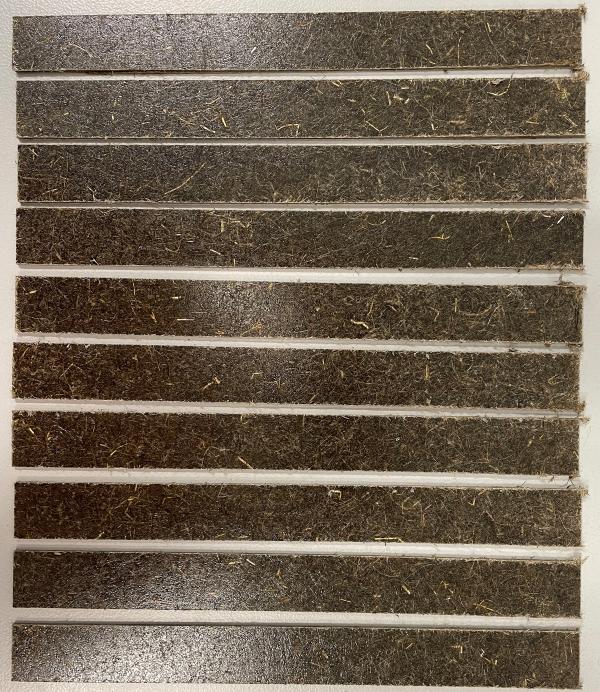
Recycling carbon fibres: Hybrid nonwovens for industrial lightweight construction
Funding duration:
Start
01.11.20
End
31.10.23
In the traditional production of technical textiles, a lot of waste is generated from cutting remnants. At the same time, the demands on the industry to develop sustainable and resource-saving alternatives are increasing. Conventional reinforcing materials such as continuous fibre textiles are reaching their limits here.
Hybrid fibre nonwovens, which combine recycled materials and thermoplastic components, offer a solution. They not only enable the reuse of waste, but also reduce the environmental impact. The VliesComp project is researching how these materials can be processed into lightweight components for machine tool construction, e-machines or medical technology.
The aim of the project team is to integrate recycled fibres from production waste into high-performance materials for lightweight construction and thus make the recycled fibres ecologically and economically usable. The focus is on the development of hybrid nonwovens consisting of thermoplastic and recycled reinforcing fibres.
These materials should not only conserve resources, but also be cost-efficient and versatile. The researchers are not aiming to achieve the maximum possible mechanical strength, but to develop customised materials for specific industrial applications.
The project team first defines the requirements for materials and processes. The researchers then develop new technologies for hybrid nonwovens by combining recycled reinforcing fibres with thermoplastic components. This results in materials that have application potential in numerous fields. With the help of modern process control and digital twins, the team optimises the production steps and tests the materials in real components.
The first applications have already been successful: The researchers have been able to manufacture components such as damping elements or housing covers entirely from recycled fibres. In doing so, they significantly improved the carbon footprint of the components - by up to 70 per cent in some manufacturing processes. And all this while maintaining the same technical performance.











